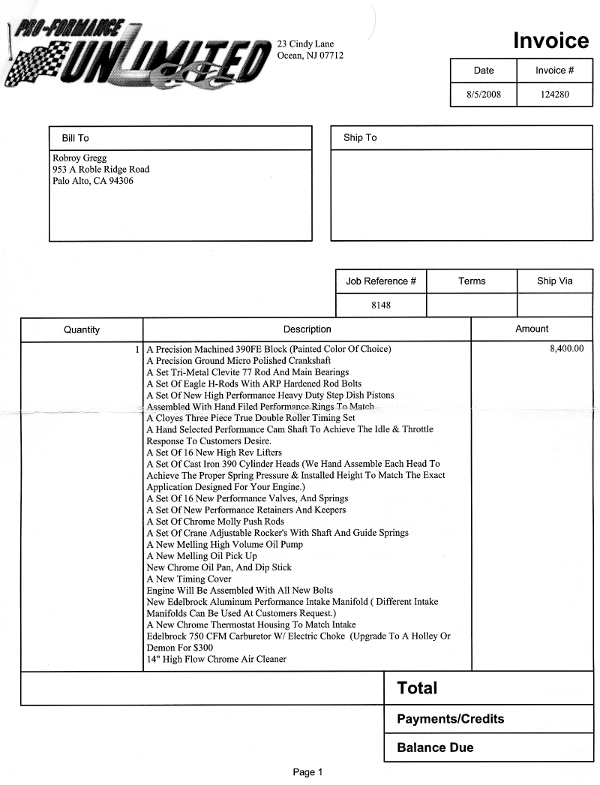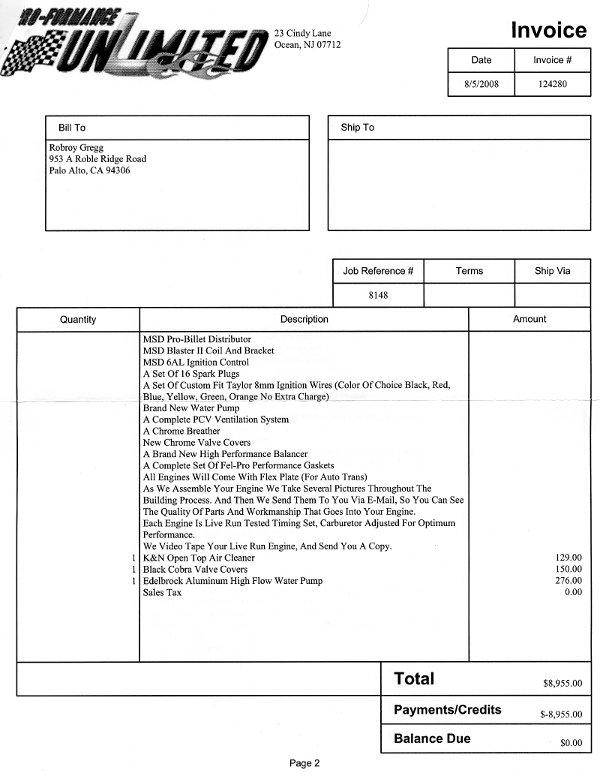It sounds like he may have been talking about when over-bored too large the cylinder walls get thin and it can lead to all sorts of problems. This is why the sonic check is done.robroy wrote:
... I heard from Tom that when an engine bore is increased, it can make the engine more difficult to cool. I also heard that in this situation it wouldn't matter very much (I'm guessing because the FE engine simply has a lot of "meat"). What are your thoughts?
robroy wrote:It looks like I have some reading to do before I'll understand these terms (other than "pump premium"DuckRyder wrote:Should be good, depending on the cam and ICA (Intake Closing Angel) will probably take pump premium. I am sure Tom will tailor the static to the cam to get a street-able Dynamic Compression Ratio.robroy wrote: [*] Tom would like to build the engine with 9.7:1 compression. He likes this ratio because there's a little room for carbon build up before the compression gets so high that detonation becomes a real problem (on high octane pump gas).), but I'm also sure that he'll take tremendous care with the specifications!
This might help:
http://cochise.uia.net/pkelley2/DynamicCR.html
Very basically if the intake valve closes later (the piston is higher in the bore) the pressure is less. A few degrees can make a big difference. The actual compression of air cannot start until the intake valve closes so if it closes later then the volume in the cylinder is less.
It isn't that important, but if it comes up. It is more curiosity on my part, people have strong brand preferences, sometimes without good reasons (sometimes with very good reasons).robroy wrote:If I remember correctly, I did hear Tom voice disapproval of the Comp Cams flat tappet camshafts, although I don't think I asked him for any anecdotes (or I've already forgotten--sorry)! This said, I will definitely be recording more video of Tom's wisdom before this adventure is complete, and I could ask him specifically about this.DuckRyder wrote:Can you expand at all on this, it sounds like Tom might not care for Comp flat tappet cams (Like me), did he have bad experiences?robroy wrote:[*] I heard from Tom that unlike their flat tappet camshafts, the Comp Cams roller camshafts are OK.
He might be able to balance the 428 crank using "Mallory metal" so that the 390 flywheel could be used. The heavy (Mallory) metal can be costly though. It is worth discussing and it is possible that using a more common 428 piston might reduce the piston cost a little.robroy wrote:Thanks for giving me your thoughts on this! I could ask Tom about whether or not he has a 428 crankshaft. I might hesitate to do this though, because if the 428 crankshaft did cost around $350, and the flywheel around $250, it could start to add up. After all, I already own a brand new Centerforce 390 flywheel. But I will ask Tom--thanks very much for this suggestion!!!"DuckRyder wrote:Since the rods appear good and it sounds as if the crankshaft will polish (polish and turn is a distinction) this becomes a matter of Cost/Benefit ratio, more CID is more displacement. If the 390 crank will simply polish up, then thats a minimal investment. If it requires turning to the next under-size, then a slightly larger investment. Some people feel that going .020 or .030 under on a crank weakens it, I think that is a non-issue here. I do wonder if Tom might have access to a 428 crank core to me a 300-400 additional investment to go to standard 428 would be worth it. (you'd have to change the flywheel too though).robroy wrote:[*] I asked Tom about stroker kits. He said that although it would increase the performance potential a lot, it would also add an extra $2,000 on to the price tag for the engine.
I thought that the port looked familiar...robroy wrote:That was a Porsche head (he discussed it with another customer who stopped by)!DuckRyder wrote:I'd go with Tom's preferences here. I was glad to see the air cooled head being CC'ed in the video (what was that, Lycoming, Continental or perhaps Porsche?).robroy wrote:[*] I asked Tom about the Edelbrock aluminum heads.
Indeed, If you can post your rear tire size we could probably figure out a much closer estimate.robroy wrote:This is news to me! Thanks for pointing this out. From the small amount of experimentation I've done with RPM calculators, I have noticed what a big difference an inch or two of tire diameter can make.DuckRyder wrote:I think it is important to remember that the F250 has a larger tire (what ~31 - ~32" diameter?) than what most of us are used to (~28") so the 3.73:1 gear won't have the same cruise characteristics as an F100 or Mustang/Torino/Fairlane/Comet/Galaxie etc, etc...
I'll certainly try the truck out with its current setup for a while before making any changes. I'll probably be doing very little freeway driving for a few years anyhow, since I'll most likely be taking a route through town to work (instead of the freeway).
I don't believe that is correct, I did notice that your block appears to have the stronger webs, but I don't think you can say with any degree of certainty that every 105 block has them and can go to a 428 bore. In fact, I don't think you can say much with certainty on FE blocks, they have been found with a great many casting anomalies. (like cross bolt provisions on one side but not the other) Some research over at the FE forum might turn up more information.robroy wrote:Last night I was reading, "How to Rebuild BIG-BLOCK FORD ENGINES," by Steve Christ, and came across this passage (page 32):
And in a caption under an image of the "105" on a block (on page 33), Steve Christ says:How to Rebuild BIG-BLOCK FORD ENGINES, by Steve Christ wrote: Some 361/391 FT blocks are cast with thicker main-bearing webs and additional ribs in between. This increases their weight about 20 pounds over the FE 390. Heavier 361/391 FT blocks do not have the 352 as cast on the left front of the standard FE block. Most heavy blocks have a mirror-image 105 on the left front, though this is missing on some blocks.
So! Does this mean I've scored with this 105 Mirror block even more significantly than I initially thought? And does this mean that I've actually got an FT block instead of an FE?How to Rebuild BIG-BLOCK FORD ENGINES, by Steve Christ wrote: In place of the 352 found on most FE blocks, many heavy-duty FT cylinder blocks have mirror image 105 on left front. In some cases, this area is left blank on heavy-duty blocks. HD blocks have additional main-bearing support and thicker main-bearing webs.





